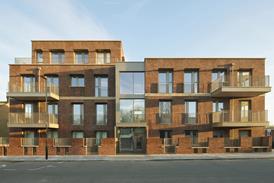A School of Place may be no bad thing, but what we really need is a core curriculum for all urban design courses, which can be rolled out everywhere, writes David Rudlin

This week I have been reading the Policy Exchange report by Ike Ijeh proposing a new School for Place. I realise that I am a bit late to the game. Many responses (several positive) were written before Christmas, but I was busy. Anyway, a friend of mine – of whom more later – suggested that I should read it and having done so I’m not sure what I think.
For those of you who haven’t read it, Ike Ijeh proposes a new school of architecture backed by government. This is not just any school of architecture – at one point it is a ”school” as in an entire architectural movement like the Chicago School. At another it is part of the grand tradition of independent architecture schools like the Bauhaus, and the AA but perhaps with less radicalism.
The Ecole des Beaux Arts in 19th century Paris – associated with a particular form of neoclassicism but also the grand planning of Haussmann – is more what they have mind. Even better it is implied, would be a version of the Notre Dame School of Architecture in Indiana, bastion of traditionalist architecture in the US, which is also associated with urban design and the new urbanist movement.
The School for Place report also suggests that it should be style neutral, teaching both traditional and contemporary architecture
The Building Better, Building Beautiful Commission was commendable for the way in which it went out of its way to avoid the automatic conflation of good placemaking with traditional architecture. The School for Place report also suggests that it should be style neutral, teaching both traditional and contemporary architecture. Although it rather undermines this studied neutrality by then suggesting that the school would address the “prejudicial stylistic imbalance that persists in many architecture schools today”.
The report goes further, suggesting that the reason for not focussing on traditional architecture is that ”any perceived political bias towards traditionalism would provoke an immediate and hostile reaction from many within the architectural community” and ”inevitably stigmatise and alienate… the very professional community it is seeking to solicit”. Not the sort of thing these reports normally say out loud!
Urban design, we suggest, actually happens at all scales, and is about managing the complexity of urban form
The friend who suggested I read the report is Ombretta Romice from the Department of Architecture at the University of Strathclyde. With a number of others, we have recently co-authored an academic paper and article that cover similar ground and which seek to define what urban design is and therefore what urban design courses should teach.
We argue that urban design has tried to stake out its territory based on scale – something that is bigger than architecture but smaller than planning. This idea that urban design is just architecture, but bigger, means that urban designers have focused on end-state masterplans, striving for something that is never reached and, in any case, can never exist.
Urban design, we suggest, actually happens at all scales, and is about managing the complexity of urban form, as well as all the things that influence it, to create resilient places. We suggest a list of things that urban designers need to know – very much the sort of thing that could be taught at the new School of Place.
Eight elements of Urban Design:
An understanding of:
1. Urban morphology and the historical development of cities.
2. Urbanism including the economic, social and environmental factors that shape cities.
An appreciation of:
3. Development and the workings of the property market, the role of other professions, viability and property law.
4. Community and the process of consultation, participation and co-creation.
5. Regulation including the workings of planning systems, design coding and policy.
6. Process – the time-based and uncertain nature of urban design and how it can be influenced over time.
And fundamentally, the capacity to:
7. Design good places with an understanding of the features of resilient areas including density, modularity, permeability, grain, legibility etc.
8. Use design tools across scales through masterplanning, spatial frameworks, regeneration strategies and coding.
An early version of this list came out of a meeting of those running urban design courses. It was organised under the auspices of the Academy of Urbanism and the Urban Design Group, just before lockdown.
Most of the courses were within architecture schools, a couple within planning schools. They all taught elements of the list, but few taught all of it. Indeed there were courses teaching urban design that were so different to each other that there was hardly any overlap.
Our suggestion is that the eight points could be used to create an accreditation system for urban design courses and eventually even be the basis for urban design becoming a profession. There is a section of the School of Place report that follows the same road and arrives at the same conclusion, which is why Ombretta told me to read it.
A School of Place may be no bad thing, but what we also need is a much clearer definition of urban design
But still I struggled to get past its basic misdiagnosis of the problem. As Michael Gove says in the preface, one of the justifications for the School of Place is to improve the quality of new housing and thereby help overcome opposition to housebuilding.
This is conflated in the report with a rehash of the Policy Exchange research into people’s preferences for traditional architecture. It seems to conclude that architects’ obsession with modernist buildings has created unpopular places which is why we need a School of Place.
A School of Place may be no bad thing, but what we also need is a much clearer definition of urban design – call it “placemaking” if you must. Let’s work out what all urban design courses should be teaching. That way employers can have confidence in what someone with an urban design qualification can be expected to know – not just the graduates of one new school.
Having got this, we can then have the debate about whether urban design should become a profession in its own right, and maybe through this gain the influence to challenge bad placemaking.
Also read >> We need a ‘School of Place’ for clients, not just architects
Postscript
David Rudlin is director of Urban Design at BDP, a former chair of the Academy of Urbanism and an honorary professor at Manchester University.
High Street: How our town centres can bounce back from the retail crisis will be published by RIBA Publishing in Spring 2023
















2 Readers' comments